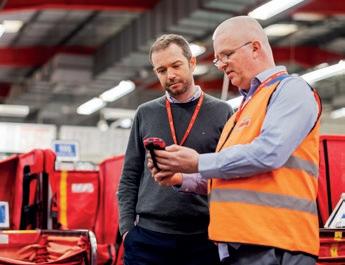
3 minute read
ION

He then moved into academia as a professor – teaching students and running research projects on behalf of the UK Government. It was while he was working at The Alan Turing Institute, named after the pioneer who helped the British Government develop the technology to decrypt Nazi Germany’s secret communications during the Second World War, that Mark was launched into the country’s most high-profile data role.
Advertisement
Analytics

Going the distance
Covid-19 had only just hit the headlines when health secretary Matt Hancock phoned Sir Adrian Smith, head of the institute, to request a handful of his best for a new team taskforce.
“Because of my defence background on radars and distance estimation, I was a natural fit. Two phones communicating with each other to infer distance isn’t too dissimilar from using a radar to figure out where an aircraft is,” he says. “I became a lead scientist on the NHS Covid-19 app.
“To be involved was certainly a career highlight. There were some scientifically reviewed papers that were published as part of our work. One showed that in England and Wales – despite all publicity around the ‘ping-demic’ – the app directly led to a reduction in Covid-related deaths by around 10,000. To prove that happened is incredible.”
One of the most high-profile projects he’s managed since joining Royal Mail is the “ability to predict into the future with forecasting”, all while helping to shape the organisation around our customer needs of the future.
“If you look at this from a delivery office level, it’s about our ability to predict the workload coming in a week to two weeks’ time so that we can resource appropriately and maximise quality of service for our customers.”
STERNICZUK Courier Editorial
Panel member and Stafford postie
KAMIL: What is the short-term and long-term data telling us?
MARK: They’re telling us that, post-Covid, consumers’ behaviour and their demands of a delivery company are changing. There’s a growing market for parcels, a declining market for letters, expectations around speed of delivery and a desire to minimally impact the planet. Fortunately, by taking an evidence-based approach, there’s lots of opportunity at Royal Mail to satisfy these customer needs. Many of the change initiatives occurring across the organisation are designed to achieve just that.
From an organisation level, it’s being able to understand what the market is going to be doing in two to four years’ time. Predicting the future can be a challenge, but it keeps Mark and his team occupied.
AI on the horizon
Since joining Royal Mail in 2021, Mark has seen artificial intelligence (AI) racing ahead and understands the importance of embracing its benefits.


“We’re already using AI in lots of different areas at Royal Mail. For instance, our estimated delivery window algorithms are a form of AI. Our business operates at an enormous scale, so to optimise our customer and colleague experience, we need the ability to process lots of different data points simultaneously. AI essentially helps us to optimise across the network.”
At the heart of Mark’s mission to enhance the customer experience is a project he and his team have nicknamed MINT. The current network has a fixed predicted day of delivery. If a Tracked 24 parcel enters our network, there’s an expected delivery day from its entry point. In reality, the network can change for many reasons. So, Mark and his team are working on how the business can ‘dynamically cope with these problems’.
“It’s kind of like having an AI ‘eye’,” he explains. “MINT gives us the capability to inform the different operational decisionmakers about problems, to optimise the route of the parcels through our network. This is a benefit across the board – from our posties to those in the senior leadership team.”
From Mark’s perspective, the world is becoming digitised – whether we like it or not. And that means moving away from an organisation steeped in 500 years of manual process to a company that adapts to a digital landscape.
“We need to be front runners in the digital world so we can out-compete the competition. As it stands, we own trust at the doorstep. It’s that human relationship that really differentiates our brand. I’d like us to continue to own that doorstep relationship, but it needs to be complemented by a digital relationship. That means making sure posties have the right information in front of them to be able to deliver.”
Delivering difference
Mark recounts a defining moment of comparison between Royal Mail and a competitor that shed light on how we’re perceived by our customers.
“The postie knocked on my door, delivered my parcel and we had a quick chat,” he recalls. “On the same day, a competitor knocked on the door and, by the time I’d answered it, he’d driven off in his van and left my parcel out in the rain.”
Mark is witness to the business opening up more channels of communication alongside digital elements to build on existing relationships with our customers.


“There’s a lot to be said about the human interaction and attention our posties put into their deliveries. Their passion for their relationships with customers is remarkable. Now we need to match that with rewarding digital interactions.”
Watch this space.
NICK: Considering the changes engulfing Royal Mail, what’s going to keep us ahead of our rivals?






